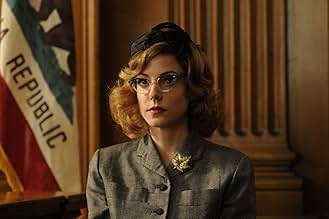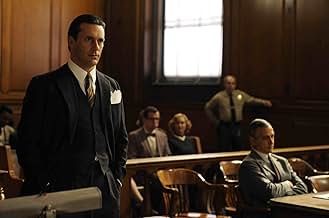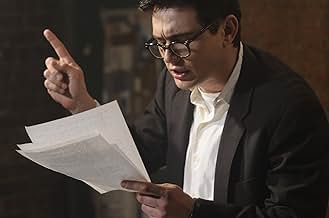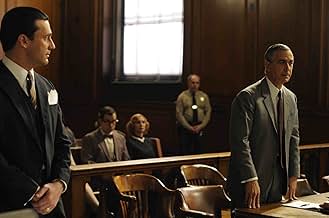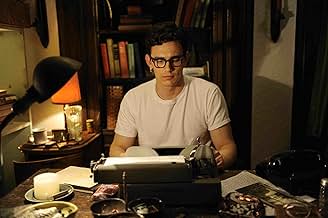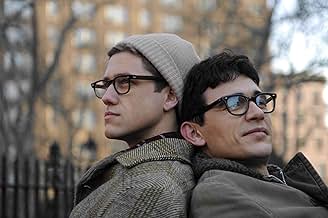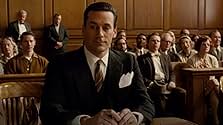As Allen Ginsberg talks about his life and art, his most famous poem is illustrated in animation while the obscenity trial of the work is dramatized.As Allen Ginsberg talks about his life and art, his most famous poem is illustrated in animation while the obscenity trial of the work is dramatized.As Allen Ginsberg talks about his life and art, his most famous poem is illustrated in animation while the obscenity trial of the work is dramatized.
- Directors
- Writers
- Stars
- Awards
- 2 wins & 8 nominations total
Kaydence Frank
- Allen's Girlfriend
- (as Kadance Frank)
Allen Ginsberg
- Self
- (archive footage)
- Directors
- Writers
- All cast & crew
- Production, box office & more at IMDbPro
Featured reviews
In admiration of James Franco and his portraying a literary person is why I wanted to see this film. Since I'd never read the poem "Howl" by Allen Ginsberg (& I knew of Ginsberg in his later years as he was fairly renown as almost an elder poet statesman), I actually dug up a copy of "Howl" and read it before I viewed the movie. It turns out that it wasn't necessary to have read "Howl" -- the film sufficiently presents the poem and its complete text so that the viewer gets a good understanding just from the movie itself (at least I thought so...). This occurs in not only Franco's public reading of "Howl," it is brought out in the animation aspect of the film -- for me the animation was unexpected yet not intrusive. What is the film's major strength is James Franco's portrayal of Ginsberg. Franco's actual physical resemblance to the younger Ginsberg adds to his portrayal and his public reading of "Howl" is also quite good.
What is additionally satisfying in my mind is the evoking of a time and place (mid 1950s America) when a group of writers and quasi-vagabonds lived their lives on their own terms (& not in accordance to what was then considered the status quo) and wrote about it. This is brought out in depictions of Ginsberg's relationships and also in the court room obscenity battle about "Howl."
What is additionally satisfying in my mind is the evoking of a time and place (mid 1950s America) when a group of writers and quasi-vagabonds lived their lives on their own terms (& not in accordance to what was then considered the status quo) and wrote about it. This is brought out in depictions of Ginsberg's relationships and also in the court room obscenity battle about "Howl."
I'm surprised that this film worked as well as it did, and that it has been received as well as it has here. I read Howl about 5 years after Ginsberg wrote it, when I was in high school, and, like it or not, it became part of my thinking in the fifty years since then. Still in high school, I could quote passages from the poem at my friends, who would follow up with the next passage, etc. Boooring. But if you had told me that a film would be made about it, with a script constructed of trial transcripts and interviews in the public record, alternating with a recreation of Ginsberg's first public (paying-public; there was ONE previous reading of the full poem) reading of the poem, I wouldn't have expected much. And I would have been wrong. It's well-done and well-acted, and no excuses are made for anything about Ginsberg or his work. I was dismayed at first to see the poem interpreted into animation, but the filmmakers were savvy enough to produce the animation in the style of the times, i.e., 1955, when Disney's Fantasia was still the state of the art, and the animation in Howl could have come out of the Night on Bald Mountain section. In the end, it worked, I think, by keeping the viewer visually in the world of the poem itself, rather than in the biographical material about Ginsberg or the trial and the litigants. So if you want to watch a movie about a poem, and the poet and his friends, but mainly about the poem, this one does a pretty good job.
Howl might be a one-of-a-kind film experience if not for Chicago 10, another film that blended documentary, dramatization and animation together into a blender of personal history. But what sets this film apart from that and all others is that poetry becomes interwoven into a courtroom trial procedural - all, apparently, taken from the actual court transcripts of what the prosecution/defense asked of the people on the stand - so that it becomes about free speech. At the same time it's a quasi-biopic on Allen Ginsberg, who was a real free spirit, but also a shy Jewish kid from New York city who lost his mother as a child and worried about writing poems that might irk the ire of his father (he even considered not publishing Howl for that reason).
It's a beautifully surreal little treat of a film that treats its subject seriously while also giving life to the epic poem that stays timeless, as with Walt Whitman's Leaves of Grass (which also gets name- dropped here). The filmmakers bring together the poetic readings - done by James Franco, one of his real 'embodiment' performances like Saul in Pineapple Express that is basically stunning - from in front of a live audience (where one sees how Ginsberg at first has an audience patient and waiting and then is full of life and looking forward to every next thing he says) and in animation. The poem becomes alive through the low-budget drawings, and depending on the stanza it can be at least acceptable and at most mind-blowing. You almost want the poem to go longer to sink in deeper to those Ginsberg stanzas that flow out with what appears to be stream of consciousness, but really has a structure to it.
Acting is fantastic - David Straithairn, Jon Hamm and in a one-scene keeper Jeff Daniels - Franco keeps things moving so well with his performance, and the poem is given it's best context in personal and social history. All of a sudden, thanks to a film like this, the material becomes alive again, like a student picking it up and sinking into it for the first time.
It's a beautifully surreal little treat of a film that treats its subject seriously while also giving life to the epic poem that stays timeless, as with Walt Whitman's Leaves of Grass (which also gets name- dropped here). The filmmakers bring together the poetic readings - done by James Franco, one of his real 'embodiment' performances like Saul in Pineapple Express that is basically stunning - from in front of a live audience (where one sees how Ginsberg at first has an audience patient and waiting and then is full of life and looking forward to every next thing he says) and in animation. The poem becomes alive through the low-budget drawings, and depending on the stanza it can be at least acceptable and at most mind-blowing. You almost want the poem to go longer to sink in deeper to those Ginsberg stanzas that flow out with what appears to be stream of consciousness, but really has a structure to it.
Acting is fantastic - David Straithairn, Jon Hamm and in a one-scene keeper Jeff Daniels - Franco keeps things moving so well with his performance, and the poem is given it's best context in personal and social history. All of a sudden, thanks to a film like this, the material becomes alive again, like a student picking it up and sinking into it for the first time.
'Howl (2010)' is an offbeat experimental historical film about Allen Ginsberg's 1956 poem "Howl," the subject of a highly-publicised obscenity trial on its initial publication. James Franco plays Ginsberg, the reluctantly homosexual poet who poured his fears and frustrations into a four-part magnum opus, deemed a masterpiece and an obscenity in equal measure. I haven't read all that much poetry (though I have been known to recite Poe's "The Raven" in my most Vincent Price-ish voice), but I did like Ginsberg's poem, which is lyrical and evocative in a manner resembling the songwriting of Tom Waits. Several computer-animated sequences attempt to ascribe visuals to Ginsberg's words, but I wasn't sure about these: the CGI animation seemed too clean, too ordered, to represent such inner torment. Worth seeing, but perhaps not for everyone.
Rob Epstein and Jeffrey Friedman's 'Howl' is an interesting and humorous depiction of the 1957 trial regarding Allen Ginsberg's controversial poem 'Howl'. In between the trial we are given glimpses of Ginsberg's life (in black and white) and an interview with him. The black and white sequences are beautifully shot. The style reminds one of French movies from the 50s. The recital of the poems takes some getting used to but once it is coupled with the animated sequence there's no turning back. It brings the poetry to life. Those are the highlights of the film. Moreover the animation is beautifully done. The pacing is uneven as its slow at times (especially in the beginning). I would have liked to have seen more glimpses of Ginsberg's life. The actors do a fairly decent job. James Franco does a good enough job and he is well supported by David Strathairn, Jon Hamm, Bob Balaban, Alessandro Nivola and Mary-Louise Parker. Overall, 'Howl' is an intriguing account and does quite well in introducing Ginsberg's poems to those who are not familiar with his works. The animation gives it a unique touch.
Did you know
- TriviaShot in 14 days around New York City in March/April 2009.
- GoofsAbout 29 minutes in, Franco (as Ginsberg) lights up a cigarette. You can clearly see a layer of digital shading (meant to darken Franco's beard) that is overlaid onto his face, esp. his left jaw. This shading also goes over Franco's hand in this scene.
- Quotes
Allen Ginsberg: There's no beat generation. It's just a bunch of guys trying to get published.
- SoundtracksTonight at the Sands
Written by Jack Arel and Jean-Claude Petit (as Jean-Caude Petit)
ZFC Music (ASCAP)
Courtesy of FirstCom Music
- How long is Howl?Powered by Alexa
Details
Box office
- Gross US & Canada
- $617,334
- Opening weekend US & Canada
- $51,185
- Sep 26, 2010
- Gross worldwide
- $1,614,810
- Runtime1 hour 24 minutes
- Color
- Sound mix
- Aspect ratio
- 1.85 : 1
Contribute to this page
Suggest an edit or add missing content







